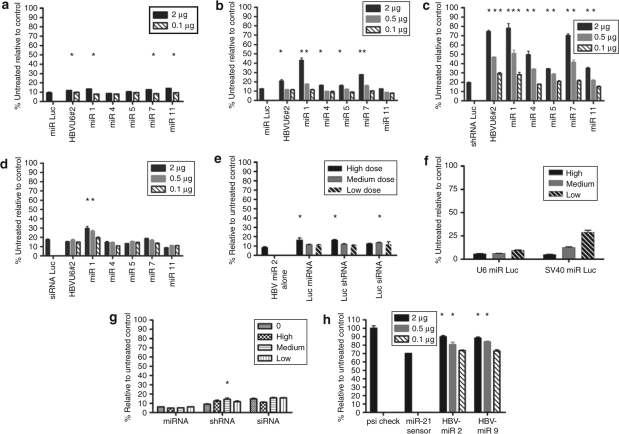Figure 6.
Competition for miRNA/RNAi machinery by shRNAs or miRNA RNAi triggers. Cells were transfected with 0.5 µg of the luciferase expression plasmid pGL3-control (Promega) as well as indicated competitor (a–d and g). Competition with a (a) high dose (1.5 µg) or (b) low dose (0.5 µg) of a luc miRNA. Competition with a (c) luc shRNA or (d) luc siRNA. Legend indicates the dose of competitor. shRNAs and HBV-miRNAs compete with miRNAs and shRNAs. HBV-miRNAs compete with siRNAs. (e) Competition of luc miRNAs, shRNAs, and siRNAs against HBV miR-2. The amount of transfected RNAi trigger was adjusted to account for differences in molecular weight. High, moderate, and low doses used in micrograms were as follows: miRNA, 2, 0.5, and 0.1; shRNA, 2, 0.5, and 0.1; siRNA 0.21, 0.053, and 0.01. (f) Comparison of silencing efficiency of Pol III-driven U6 miR Luc and Pol II-driven SV40 miR Luc shows that SV40 miR Luc is less potent. The amount of transfected RNAi trigger was adjusted for molecular weight. High, medium, and low doses were the following (in micrograms): U6 miR Luc, 2, 0.5, and 0.1; SV40 miR Luc, 2.7, 0.7, and 0.13. (g) Competition of exogenous Pol II-driven SV40 HBV-miR 2 with an exogenous miRNA Luc, shRNA,Luc or siRNA Luc. Doses used were as in e. (h) HBV-miRNAs compete with endogenous miR-21. Cells were co-transfected with a miR-21 sensor that contains a bulged miR-21 binding site in the 3′ untranslated region of the renilla luciferase gene of psicheck 2 as well as indicated amounts HBV-miR 2 or HBV-miR 9. Asterisks indicate statistical significance (P < 0.05). Error bars indicate mean ± SD. HBV, hepatitis B virus; miRNA, microRNA; RNAi, RNA interference; shRNA, short hairpin RNA.

